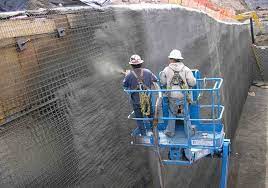Spraying concrete, also known as shotcrete or gunite, is a process of applying concrete through a high-pressure hose onto a surface. This method finds application in diverse construction projects, spanning building foundations, swimming pools, and retaining walls. The following are the essential things you need to know about spraying concrete.
Types of Spraying Concrete
There are two main types of spraying concrete: wet-mix and dry-mix. In the wet-mix method, the concrete is mixed with water before being sprayed onto the surface. Wet-mix is commonly used for large construction projects, as it’s more efficient and cost-effective. Dry-mix, on the other hand, involves mixing the dry ingredients before they’re fed into the spraying machine. Dry-mix is often used for smaller projects and repairs.
Benefits of Spraying Concrete
Spraying concrete has several benefits over traditional pouring methods. Here are some of the advantages of using sprayed concrete:
Reduced Labor and Time: Spraying concrete is a faster process than traditional pouring methods. Employing high-pressure hoses enables faster and more efficient applications, effectively minimizing the requirement for manual labor.
Enhanced Strength: The high-pressure application of concrete results in a denser and stronger finished product. The method also reduces the risk of segregation and provides better bonding.
Increased Flexibility: Spray concrete is a versatile method that can be applied to various surfaces and shapes, making it ideal for complex projects.
Reduced Material Waste: The use of high-pressure hoses reduces material waste, as the concrete is applied only where needed.
Lowered Cost: Due to its faster application and reduced labor requirements, spray concrete can be a cost-effective alternative to traditional pouring methods.
Application Process
The application process for spraying concrete involves the following steps:
Surface Preparation: The surface must be prepared before spray concrete. The preparation process includes cleaning, leveling, and ensuring that the surface is free of debris and contaminants.
Mix Preparation: The concrete mix is prepared according to the project specifications. The mix must be consistent and free of lumps to ensure proper spraying.
Spraying: The concrete is sprayed onto the surface using a high-pressure hose. The nozzle of the hose can be adjusted to achieve the desired texture and thickness.
Finishing: Once the concrete is applied, it’s troweled to achieve the desired finish. The troweling process can be done by hand or using a power trowel.
Safety Precautions
Spraying concrete can be a hazardous process if proper safety measures aren’t taken. The following are some safety precautions that should be followed when spray concrete:
Protective Gear: All personnel involved in spray concrete must wear protective gear, including eye protection, gloves, and respiratory masks.
Ventilation: Adequate ventilation is essential to prevent the buildup of dust and fumes during spraying.
Equipment Safety: All equipment used for spray concrete must be properly maintained and inspected to ensure safe operation.
Training: Only trained and experienced personnel should be allowed to operate the spraying equipment.
Cleaning: All equipment and tools used in spraying concrete must be cleaned and maintained regularly to prevent equipment failure and contamination.
Conclusion
Spraying concrete is a fast and efficient method for applying concrete to surfaces. The technique provides numerous benefits over traditional pouring methods, including reduced labor and time, enhanced strength, increased flexibility, reduced material waste, and lowered cost. However, spray concrete can be a hazardous process if proper safety measures aren’t taken. Therefore, it’s essential to follow safety precautions and ensure that all personnel involved in the process are trained and experienced. With these considerations in mind, spray concrete can be an effective and reliable method for various construction projects.

